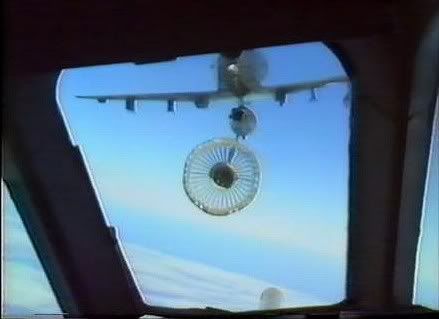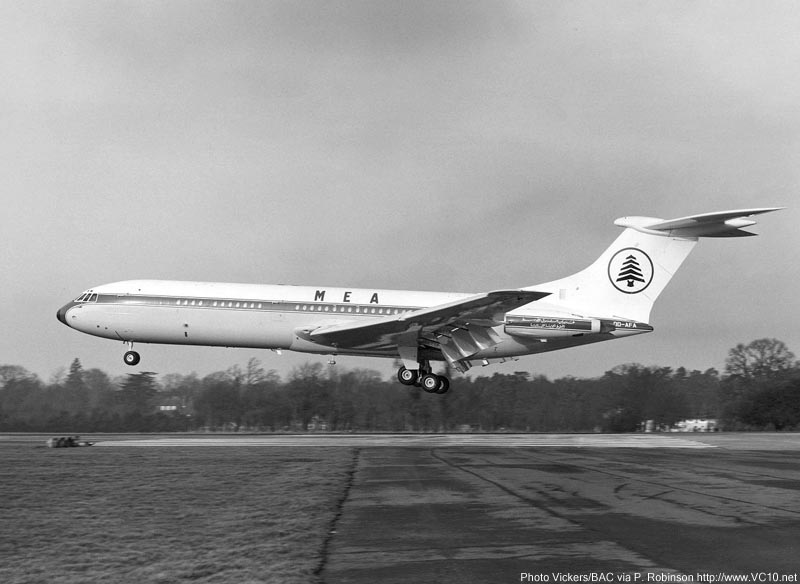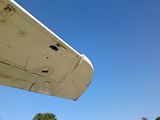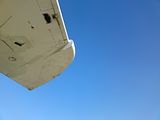The VC 10
.886 was MNO on the RAF VC10s as well, but MMO was higher, (.925 I think). To prevent the record being beaten until HOTOL came along, they got authorisation to cruise at 0.9.
The RAF Standards (Mk C1s) do have the tail fin tank - but they aren't actually standards. They had the standard fuselage but Super wings, gear and engines. So they are really shorter Supers with a freight door.
The RAF Standards (Mk C1s) do have the tail fin tank - but they aren't actually standards. They had the standard fuselage but Super wings, gear and engines. So they are really shorter Supers with a freight door.
Thanks, Dan,
Did the RAF's C1s also have an APU? We could certainly have used one in West Af for air con, and of course some of the air trucks on offer were pretty poor on hot days for engine starting.
BCAL's Standards – including G-ARTA, the ex-prototype – also had what was referred to as a "super" wing, enabling FL430, as I said in a previous post. Unlike the real Supers, there was a characteristic "droop-snoot" L/E near the tips. Did yours have that? We also had freight doors, except perhaps on G-ARTA.
The Ten at Brooklands is oor ex-G-ASIX, I believe.
Did the RAF's C1s also have an APU? We could certainly have used one in West Af for air con, and of course some of the air trucks on offer were pretty poor on hot days for engine starting.
BCAL's Standards – including G-ARTA, the ex-prototype – also had what was referred to as a "super" wing, enabling FL430, as I said in a previous post. Unlike the real Supers, there was a characteristic "droop-snoot" L/E near the tips. Did yours have that? We also had freight doors, except perhaps on G-ARTA.
The Ten at Brooklands is oor ex-G-ASIX, I believe.
The C1s were APU equipped at build. All the tankers were fitted with APUs on conversion if they didn't have them. Don't think they have the wingtips you describe.
Originally Posted by Chris Scott
BCAL's Standards – including G-ARTA, the ex-prototype – also had what was referred to as a "super" wing, enabling FL430, as I said in a previous post. Unlike the real Supers, there was a characteristic "droop-snoot" L/E near the tips. Did yours have that? We also had freight doors, except perhaps on G-ARTA.
The Ten at Brooklands is oor ex-G-ASIX, I believe.
The Ten at Brooklands is oor ex-G-ASIX, I believe.
There were two major changes to the wing after the initial run of BOAC Standards: the wing chord was increased by 4% and the 'Kuchemann' wingtips were available as an option. I think the RAF and BOAC Supers never had these wingtips. Also (although I stand to be corrected) G-ARTA may not have been refitted with the wing chord extension, just the wing tips! The wing chord extension is visible as a step in the leading edge at aproximately 60% of the span, near the small outboard fence. It can be seen on this drawing:
http://www.vc10.net/images/wing_srm.jpg
Join Date: Jan 2001
Location: Witney UK
Posts: 616
Likes: 0
Received 0 Likes
on
0 Posts
I was one of the crew that took over the UK / Australia aircraft after its 0.9 M adventure and to say the least it did rather rattle. However that may be because it had also been very close behind an A4 in New Zealand and made contact with its refuelling kit. We still managed to complete the other half of round the world so the aircraft did not let us down.
Brain Potter, you're right. If anyone had requested a M0.9 cruise, permission would have been refused. So they cruised at whatever it would do without asking.....
Don't even ask about the AAR brackets! I did the first; once they were in contact we increased the IAS to whatever they could cope with. Once complete, we climbed and turned out of their way back to Akrotiri; they thundered on across Egypt. I later discovered that their Air Eng had 'filled to full', putting the aircraft a long way outside the normal envelope....
They roared onwards to the TriStar bracket over the Indian Ocean and went pedal to the metal all the way to Oz. God knows how much fatigue was used for the record; as an Air Wheel later said "No doubt a few limits were encroached upon to secure the record!".
When we landed back in Akrotiri, the APC squadron was quite cross. They'd been having to save fuel for weeks and yet there we were "wasting thousands of kilos just for an ego trip", as they put it. It's not easy to find any counter argument to that.

Updick really shouldn't have left the crewroom whilst we were watching the video... Normally he wouldn't let it out of his sight, but his PA told him that the Stn Cdr was on the phone. As soon as he'd rushed off to his office, we grabbed the squadron's portable (-ish...
Normally he wouldn't let it out of his sight, but his PA told him that the Stn Cdr was on the phone. As soon as he'd rushed off to his office, we grabbed the squadron's portable (-ish... ) video recorder, did a rapid tape-to-tape transfer, then hid all the evidence before he came back. He never found out.....
) video recorder, did a rapid tape-to-tape transfer, then hid all the evidence before he came back. He never found out.....
Don't even ask about the AAR brackets! I did the first; once they were in contact we increased the IAS to whatever they could cope with. Once complete, we climbed and turned out of their way back to Akrotiri; they thundered on across Egypt. I later discovered that their Air Eng had 'filled to full', putting the aircraft a long way outside the normal envelope....

They roared onwards to the TriStar bracket over the Indian Ocean and went pedal to the metal all the way to Oz. God knows how much fatigue was used for the record; as an Air Wheel later said "No doubt a few limits were encroached upon to secure the record!".
When we landed back in Akrotiri, the APC squadron was quite cross. They'd been having to save fuel for weeks and yet there we were "wasting thousands of kilos just for an ego trip", as they put it. It's not easy to find any counter argument to that.
However that may be because it had also been very close behind an A4 in New Zealand and made contact with its refuelling kit.

Updick really shouldn't have left the crewroom whilst we were watching the video...
 Normally he wouldn't let it out of his sight, but his PA told him that the Stn Cdr was on the phone. As soon as he'd rushed off to his office, we grabbed the squadron's portable (-ish...
Normally he wouldn't let it out of his sight, but his PA told him that the Stn Cdr was on the phone. As soon as he'd rushed off to his office, we grabbed the squadron's portable (-ish... ) video recorder, did a rapid tape-to-tape transfer, then hid all the evidence before he came back. He never found out.....
) video recorder, did a rapid tape-to-tape transfer, then hid all the evidence before he came back. He never found out.....
BUA/BCAL Wings
BEagle,
I wonder what the fuel flow was at M0.9 after you refuelled them... Were they also flying low for a higher TAS?
Hi Jhieminga,
Returning to more mundane matters: all you say about the wing changes after the initial run of BOAC "Standards" (1101s) makes sense, thanks. It seems that the "Super" wing that was fitted to the "Standard" fuselages of the BUA/BCAL and RAF C1 aeroplanes is defined by the chord extension, whereas the droop-snoot Kuchemann wing-tips may have been unique to the BUA order. My self-written notes from the talk-and-chalk course at the Bee-Hive in 1971 confirm the former, and mention a figure of about five inches at the leading edge. For whatever reason I failed to mention the wing tips, although the instructor did.
The first three BUA aircraft – G-ASIW, IX, and G-ATDJ, were designated 1103s with cabin freight doors. When BUA acquired G-ARTA, she was designated 1109, with no such freight door. But I'm confident she had the same wing as the other three, or we would have needed different cruise-performance data for the buffet margins, at least: we didn't. (Also, the 1101s were restricted to FL410, IIRC.) Therefore she must have had the wing-chord extensions, and I think that argument might also apply to the Kuchemann wing tips. Presumably, they would have been tested on her for certification purposes, and it would probably have been widely acknowledged if she hadn't got them.
I wonder what the fuel flow was at M0.9 after you refuelled them... Were they also flying low for a higher TAS?
Hi Jhieminga,
Returning to more mundane matters: all you say about the wing changes after the initial run of BOAC "Standards" (1101s) makes sense, thanks. It seems that the "Super" wing that was fitted to the "Standard" fuselages of the BUA/BCAL and RAF C1 aeroplanes is defined by the chord extension, whereas the droop-snoot Kuchemann wing-tips may have been unique to the BUA order. My self-written notes from the talk-and-chalk course at the Bee-Hive in 1971 confirm the former, and mention a figure of about five inches at the leading edge. For whatever reason I failed to mention the wing tips, although the instructor did.
The first three BUA aircraft – G-ASIW, IX, and G-ATDJ, were designated 1103s with cabin freight doors. When BUA acquired G-ARTA, she was designated 1109, with no such freight door. But I'm confident she had the same wing as the other three, or we would have needed different cruise-performance data for the buffet margins, at least: we didn't. (Also, the 1101s were restricted to FL410, IIRC.) Therefore she must have had the wing-chord extensions, and I think that argument might also apply to the Kuchemann wing tips. Presumably, they would have been tested on her for certification purposes, and it would probably have been widely acknowledged if she hadn't got them.
Last edited by Chris Scott; 27th Sep 2011 at 12:10. Reason: Minor improvements.
That's the one, tristar 500, with an appropriate blue-sky background.
Having been the launch customer for the One-Eleven, I wonder if BUA may have been particularly interested in deep-stall protection.
Thanks!
Chris
Having been the launch customer for the One-Eleven, I wonder if BUA may have been particularly interested in deep-stall protection.
Thanks!
Chris
Bill Gunston's 'The Cambridge Aerospace Dictionary' has this to say:
Küchemann tip
Low-drag wingtip following outward-curved streamlines, with large-radius curve from leading edge to corner at trailing edge.
From this I'm surmising that it's the shape in top view that defines this as a 'Kuchemann tip'. The larger camber of this tip is something else again, which did enable the aircraft to operate at a higher cruise flight level apparently. I'm still trying to figure out the how and the why though.
I've been looking at photos of G-ARTA post conversion to see if I can identify the wing chord extension and tips, in the larger version of this image below it does appear that the wing chord extension was fitted. I agree that the performance data in the manuals would otherwise have reflected the different specs of the aircraft had the wing not been modified. From staring at the photos I cannot confirm the tips though.

I don't think that the modified wing was tested on G-ARTA. The 1102 and 1103 VC10s for Ghana Airways and BUA both had the modified wing and I think that they did the flight testing of the modifications on these aircraft (G-ASIW probably as I have photos of this aircraft with 1101 style wing fences and without the downturned tips). G-ARTA wasn't modified for airline service until 1966/67 and by then the BUA and GA aircraft had been in operation for a while. Also they had G-ASGA, the first Super, which was also flying with the newer wing by 1964. With all that I thnk that there was no need to refit the wing to G-ARTA until she was bought by Freddie Laker.
Another question: is anyone able to confirm that G-ASGD was named 'Canopus' on a plaque inside the aircraft as the 'Flagship' of the fleet?
Küchemann tip
Low-drag wingtip following outward-curved streamlines, with large-radius curve from leading edge to corner at trailing edge.
From this I'm surmising that it's the shape in top view that defines this as a 'Kuchemann tip'. The larger camber of this tip is something else again, which did enable the aircraft to operate at a higher cruise flight level apparently. I'm still trying to figure out the how and the why though.
I've been looking at photos of G-ARTA post conversion to see if I can identify the wing chord extension and tips, in the larger version of this image below it does appear that the wing chord extension was fitted. I agree that the performance data in the manuals would otherwise have reflected the different specs of the aircraft had the wing not been modified. From staring at the photos I cannot confirm the tips though.

I don't think that the modified wing was tested on G-ARTA. The 1102 and 1103 VC10s for Ghana Airways and BUA both had the modified wing and I think that they did the flight testing of the modifications on these aircraft (G-ASIW probably as I have photos of this aircraft with 1101 style wing fences and without the downturned tips). G-ARTA wasn't modified for airline service until 1966/67 and by then the BUA and GA aircraft had been in operation for a while. Also they had G-ASGA, the first Super, which was also flying with the newer wing by 1964. With all that I thnk that there was no need to refit the wing to G-ARTA until she was bought by Freddie Laker.
Another question: is anyone able to confirm that G-ASGD was named 'Canopus' on a plaque inside the aircraft as the 'Flagship' of the fleet?
Last edited by Jhieminga; 16th Oct 2011 at 20:14.
Another question: is anyone able to confirm that G-ASGD was named 'Canopus' on a plaque inside the aircraft as the 'Flagship' of the fleet?
Planemike
It's been discussed on my forum here: A Little VC10derness • View topic - Flagships and the naming of BOAC/BA aircraft
That was a while ago, I was wondering if there are more people who remember this. I haven't been able to verify this from books or other sources.
That was a while ago, I was wondering if there are more people who remember this. I haven't been able to verify this from books or other sources.
Join Date: Jan 2008
Location: Finland
Age: 77
Posts: 465
Likes: 0
Received 0 Likes
on
0 Posts
Yes G-ASGD was called Canopus and if memory serves me there was a plaque.
I was told, when I was on the fleet, that it was the only one with a name and that it was so named because there had always been a Canopus in BOAC.
I always felt it sad that the Tristars were named after roses and not stars!!
I wonder who has the plaque now.
I was told, when I was on the fleet, that it was the only one with a name and that it was so named because there had always been a Canopus in BOAC.
I always felt it sad that the Tristars were named after roses and not stars!!
I wonder who has the plaque now.
A Runyonesque Character
Join Date: Apr 2004
Location: The South of France ... Not
Age: 74
Posts: 1,209
Likes: 0
Received 1 Like
on
1 Post
finncapt: I always felt it sad that the Tristars were named after roses and not stars!!
I submitted a list of ‘Derby Winners’, which I thought was appropriate given that’s where the RB211s came from. I was amazed when I didn’t win.
Join Date: Jun 2008
Location: Kerry Eire
Age: 76
Posts: 609
Likes: 0
Received 0 Likes
on
0 Posts
Why The SSK probably didn't win
Whilst the RB211 was built in Derby the RB stood for Rolls Barnodswick, where the engine was designed. As for it being a "Derby Winner", the problems with the engine hardly made it a winner at the time BA received its L1011s as the problems with the engine crippled Rolls Royce, damaged the government, cost the taxpayer and seriously delayed the delivery of the aircraft.
BA would hardly have wanted a reminder to its passengers and staff painted on the aircraft.
BA would hardly have wanted a reminder to its passengers and staff painted on the aircraft.
A quick addition to this thread, I just got this photo and it clearly shows the leading edge extension and on the 100% version it appears that the downturned wingtips are there as well.


Join Date: Jan 2001
Location: In "BIG SKY".
Age: 84
Posts: 418
Likes: 0
Received 0 Likes
on
0 Posts
Didn't the BUA VC-10's have air bottles in the tail cone for starting where no external air was available??
I seem to remember that they had bottles as the Supers with East African did not??
Correct me if I am wrong. It was a long time ago.
Speedbird 48
I seem to remember that they had bottles as the Supers with East African did not??
Correct me if I am wrong. It was a long time ago.
Speedbird 48
Starting Combuster System
Thanks Jhieminga,
For the superb photo. What a lucky angle... Not sure I can see the Küchemann tip, though.
Quote from Speedbird48:
Didn't the BUA VC-10's have air bottles in the tail cone for starting where no external air was available??
Yes, according to my 1971 notes (ground school at Gatwick Bee Hive, instructor Pete Horscroft):
3 bottles of AIR (not, of course, nitrogen) at 3000psi. This was reduced to 300psi by a PRV, i.e., to "HP air" pressure.
But the amount of HP air was not itself sufficient to do the job of turning the normal pneumatic starter, so there was a combustor unit fitted between the PRV and the appropriate pneumatic engine starter (#3, but it could be refitted to #4). This stored and burned normal fuel, presumably to increase the mass flow (don't know what happened to the pressure) of air to the starter.
Sounds horrendous, and I don't think we used it very often (and that would have been the grizzled F/E's job, fortunately). Seems odd if the starter, which would normally use LP air at 25psi - 40psi, was also able to withstand HP air of at least 300psi? There is no PRV between the combustor and the starter, only a dump valve which dumps most of the air for the first 2 seconds, to give the starter a chance to start rotating before the full flow of air is introduced for a further 18 seconds.
According to my notes, Pete H also told us that the combustor burn is limited to 20 seconds to protect the starter from overheating by the hot air. (Amazing how much detailed, inside knowledge our ground-school instructors used to impart...) The RAF did well to specify an APU, I reckon.
(For the uninitiated, the remaining engines would subsequently be started by a conventional "crossbleed start", like most passenger jets, using LP air bled from the #3 engine, which has to be accelerated above idle rpm for the purpose.)
For the superb photo. What a lucky angle... Not sure I can see the Küchemann tip, though.
Quote from Speedbird48:
Didn't the BUA VC-10's have air bottles in the tail cone for starting where no external air was available??
Yes, according to my 1971 notes (ground school at Gatwick Bee Hive, instructor Pete Horscroft):
3 bottles of AIR (not, of course, nitrogen) at 3000psi. This was reduced to 300psi by a PRV, i.e., to "HP air" pressure.
But the amount of HP air was not itself sufficient to do the job of turning the normal pneumatic starter, so there was a combustor unit fitted between the PRV and the appropriate pneumatic engine starter (#3, but it could be refitted to #4). This stored and burned normal fuel, presumably to increase the mass flow (don't know what happened to the pressure) of air to the starter.
Sounds horrendous, and I don't think we used it very often (and that would have been the grizzled F/E's job, fortunately). Seems odd if the starter, which would normally use LP air at 25psi - 40psi, was also able to withstand HP air of at least 300psi? There is no PRV between the combustor and the starter, only a dump valve which dumps most of the air for the first 2 seconds, to give the starter a chance to start rotating before the full flow of air is introduced for a further 18 seconds.
According to my notes, Pete H also told us that the combustor burn is limited to 20 seconds to protect the starter from overheating by the hot air. (Amazing how much detailed, inside knowledge our ground-school instructors used to impart...) The RAF did well to specify an APU, I reckon.
(For the uninitiated, the remaining engines would subsequently be started by a conventional "crossbleed start", like most passenger jets, using LP air bled from the #3 engine, which has to be accelerated above idle rpm for the purpose.)






